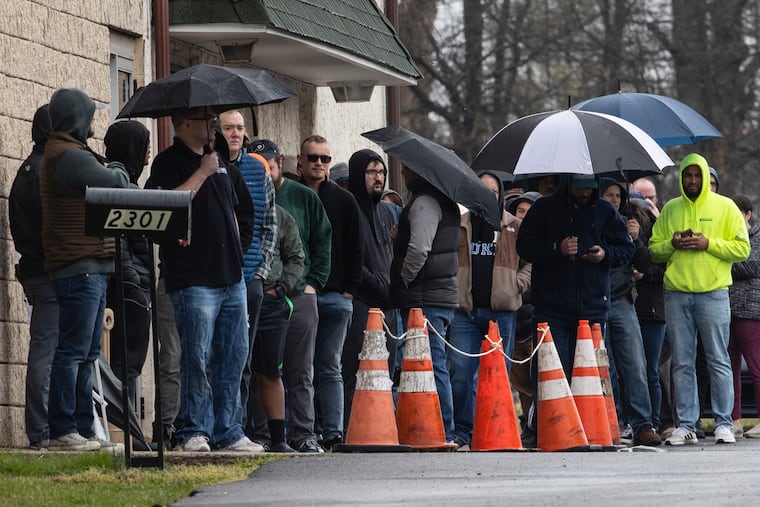Safe firearm storage will save lives as gun demand surges during COVID | Opinion
An estimated three million more guns have sold during this pandemic than expected.

In March, COVID-19 shattered Americans’ sense of safety and security. Amid rising sales of bleach and toilet paper, another retail trend emerged: firearms. Since the start of the pandemic, firearm sales have skyrocketed, with an estimated three million more guns sold than expected. Sales hit record highs following the killing of George Floyd and subsequent national turmoil, with 3.9 million firearms sold in June alone — 1.4 million more than normally expected in June. And many individuals are first-time buyers.
This rise in firearm ownership is an opportunity to ensure that all new gun owners safely store their firearms when not in use, following best practices recommended by public health and firearm safety experts. Safer firearm storage saves lives.
» READ MORE: Gun sales are surging. Here’s what you need to know about gun safety.
In 2018, 3,335 young people (aged 1 to 19) died of firearm injuries, specifically homicide (55%), suicide (39%), and unintentional injury (3%). Studies show that more than 75% of the firearms used in youth suicide attempts and unintentional injuries are stored in the home of a parent, friend, or relative. Focusing on safe firearm storage in the home and other places where youth may have unauthorized access to prevent firearm injury and mortality (like cars) is incredibly critical.
A 4-year-old finds a handgun in his parent’s bedroom closet and fatally shoots himself while his father is asleep. An 11-year-old dies after shooting himself during a Zoom class. Variations of these reports are far too familiar. At a time when kids are spending more time at home during school closures, navigating disruption to their routines, and experiencing emotional stressors, firearm safety is arguably more important than ever.
To keep young people safe, public health researchers and firearm safety experts recommend three practical tips for new gun owners: 1) secure storage, 2) skilled handling, and 3) familiarity with the law in your jurisdiction.
First and foremost, ensure that your firearms are stored securely. Leading organizations such as the National Shooting Sports Foundation and the American Academy of Pediatrics recommend that firearms be stored locked, unloaded, and with ammunition locked separately. To that point, it’s important to develop a storage plan even before obtaining a firearm. Also, think through “hassle factors,” the minor inconveniences that can interfere with safe storage, like not having cable lock instructions readily available. To make it easier, buy everything you need at once — purchase all necessary security items such as storage safes and locks along with the firearm.
Second, regardless of experience level, take a firearms safety course to solidify your safe handling skills under the capable eye of a certified instructor. As with planning for safe storage, find a safety course you can attend before purchasing a firearm. While not a replacement for in-person instruction, online safety courses are available in response to COVID-19 social distancing measures.
» READ MORE: Philly-area gun shops say COVID-19, protests, presidential election driving widespread shortages
Third, understand the laws regarding defensive use, storage, transportation, and firearm ownership — especially as these regulations can vary by local jurisdiction. For example, 27 states and Washington, D.C. have child access prevention laws to encourage safe storage of firearms and unauthorized access. In addition, several states have mandatory loss and theft reporting laws, with varying time frames for reporting a missing firearm to law enforcement. Firearm regulation is complex, and many tend to avoid information when it’s overwhelming. The Giffords Law Center provides a streamlined, one-stop resource for state-specific regulations.
As we navigate the massive uncertainty imposed by COVID-19, one thing we can be certain of: We need to work together to keep young people safe. With an increase in new firearm ownership, best practices related to secured storage, skilled handling, and familiarity with the law are vital to preventing unauthorized access to firearms. By following these guidelines, we can prevent injury and save lives.
If you or someone you know is thinking of suicide, call the National Suicide Prevention Lifeline at 1-800-273-8255 or text TALK to the Crisis Text Line at 741741.
Katelin Hoskins is a postdoctoral fellow with the Penn Center for Mental Health in the Perelman School of Medicine at the University of Pennsylvania. Jose Morales is a U.S. Army veteran, certified firearms instructor, and owner of Philly Firearms Academy who has taught about firearm safety for over 25 years. Rinad Beidas is an associate professor in the departments of psychiatry, medical ethics and health policy, and medicine at Penn.